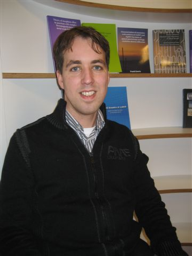Fluid dynamics at a pinch
Droplet and bubble formation in microfluidic devices
Promotion date: 23. March 2011
Promotor: Prof. dr. Detlef Lohse
Assistant promotor: Dr. Michel Versluis
| The formation of microscopically small droplets and bubbles with an accurately controlled and narrow size distribution, is crucial in a wide variety of products and applications, such as diagnostic ultrasound imaging, targeted drug delivery, drug inhalation therapy, but also in inkjet printing, cosmetics and in the modern food industry. The research presented discusses various aspects of droplet and bubble formation in different microfluidic systems, both experimentally and numerically. High monodisperse microbubble formation is achieved in low aspect ratio channel geometries, whereas square geometries favour high bubble production rates. Using ultra high-speed imaging at one million frames per second, bubble and droplet formation is investigated in more detail both in space and time enabling the pinch-off singularity to be approached to within one microsecond. |
Can you mention an example where the formation of equally-sized microdroplets is an important issue?
For example in inhalation spray medicines, the droplet size is of prime importance to have a positive healing effect in the lungs: if too big, the patient may start coughing heavily, if too small the medicine disappears out of the system by breathing before being active in the first place. By applying exact droplet size, possibilities to exactly dose the medicine necessary, are many times more favourable.
The research project was part of the MicroNed programme, including company sponsorship from MedSpray, Océ, Friesland/Campina and others.
Was your research pointed to direct application or of a more fundamental level?
The topic of research was in close collaboration with industry. For various medical and industrial applications, it is crucial to understand how a single microdroplet or microbubble is created. These formation processes are extremely fast, thus it was necessary to capture the events using the Brandaris 128 ultra-high-speed camera recording at a speed up to 25 million frames per second.
We combined the experimental tools with theory and numerical calculations and found that the
geometry of the microfluidic channel is very important in controlling the size of the bubbles and the speed of forming them. Rectangular thin-shaped channels are favourable for controlling small bubbles, generally speaking.
Will your research line be continued in the future?
The Physics of Fluids group certainly will. There are many challenging topics in the area, for example using different fluids, such as conducting polymers, for inkjet printing electronics. Another issue involves the possibility of coating microbubbles, creating a shield around them in a way they are not soluble instantly in the human body.
What was it like, working at the Mesa+ institute?
I was a member of the Physics of Fluids group first and foremost, but MESA+ was helpful for learning new processes and talking with various colleagues about all aspects involved. In a thesis project, working at MESA+ offered lots of possibilities to create one’s own specific research goals. Social events are important in my opinion, to create this atmosphere and finding new partners to cooperate with, be it the MESA+ day or BBQ parties.
What are your future plans?
Shortly, I will start working as a postdoc on a project setting up a new research line on microbubbles as medical contrast agents for a pharmaceutical company in Geneva. Beyond that I will see where life takes me.

